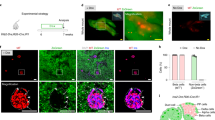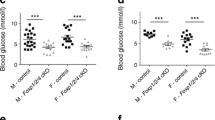Abstract
The mammalian pancreas contains two distinct cell populations: endocrine cells which secrete hormones into the bloodstream, and exocrine cells, which secrete enzymes into the digestive tract1. The four endocrine cell types found in the adult pancreas—α, β, δ and PP—synthesize glucagon, insulin, somatostatin and pancreatic polypeptide, respectively2. All of these endocrine cells arise from common multipotent precursors, which coexpress several hormones when they start to differentiate3. Expression of some homeobox genes in the early developing pancreas has been reported4–7. The Pax4 gene is expressed in the early pancreas, but is later restricted to βcells. Inactivation of Pax4 by homologous recombination results in the absence of mature insulin-and somatostatin-producing cells (β and δ, respectively) in the pancreas of Pax4 homozygous mutant mice, but glucagon-producing α cells are present in considerably higher numbers. We propose that the early expression of Pax4 in a subset of endocrine progenitors is essential for the differentiation of the β and δ cell lineages. A default pathway would explain the elevated number of α cells in the absence of Pax4.
Similar content being viewed by others
References
Slack, J. M. W. Developmental biology of the pancreas. Development 121, 1569–1580 (1995).
Pictet, R. L. An ultrastructural analysis of the developing embryonic pancreas. Dev. Biol. 29, 436–467 (1972).
Alpert, S., Hanahan, D. & Teitelman, G. Hybrid insulin genes reveal a developmental lineage for pancreatic endocrine cells and imply a relationship with neurons. Cell 53, 295–308 (1988).
Oliver, G. et al. Prox 1, a prospeo-elated homeobox gene expressed uring mouse development. Mech. Dev. 44, 3–16 (1993).
Raju, K. et al. Characterization and developmental expression of TIx-1, the murine homolog of Hox11. Mech. Dev. 44, 51–64 (1993).
Turque, N., Plaza, S., Radvanyi, F., Carriere, C. & Saule, S. Pax-QNR/Pax-6, a paired box- and homeobox-containing gene expressed in neurons, is also expressed in pancreatic endocrine cells. Mol. Endocrinol. 8, 929–938 (1994).
Wright, C. V. E., Schnegelsberg, P. & De Robertis, E. M. XIHbox 8: a novel Xenopus homeo protein restricted to a narrow band of endoderm. Development 104, 787–794 (1988).
Walther, C. et al. Pax: a murine multigene family of paired box-containing genes. Genomics 11, 424–434 (1991).
Jonsson, J., Carlsson, L., Edlund, T. & Edlund, H. Insulin-promoter factor 1 is required for pancreas development in mice. Nature 371, 606–609 (1994).
Offield, M. F. et al. PDX-1 is required for pancreatic outgrowth and differentiation of the rostral duodenum. Development 122, 983–995 (1996).
Guz, Y. et al. Expression of murine STF-1, a putative insulin gene transcription factor, in β-cells of pancreas, duodenal epithelium and pancreatic exocrine and endocrine progenitors during ontogeny. Development 121, 11–18 (1995).
Ohlsson, H., Karlsson, K. & Edlund, T. IPF1, a homeo-domain containing transactivator of the insulin gene. EMBO J. 13, 1145–1158 (1994).
Miller, C. P., McGehee, R. E. & Habener, J. F. IDX-1: a new homeodomain transcription factor expressed in rat pancreatic islets and duodenum that transactivates the somatostatin gene. EMBO J. 13, 1145–1156 (1994).
Teitelman, G., Alpert, S., Polak, J. M., Martinez, A. & Hanahan, D. Precursor cells of mouse endocrine pancreas coexpress insulin, glucagon and the neuronal proteins tyrosine hydroxylase and neuropeptide Y, but not pancreatic polypeptide. Development 118, 1031–1039 (1993).
Githens, S. in The Pancreas: Biology, Pathobiology, and Disease 2nd edn (ed. V. L. W. Go et al.) 21–73 (Raven, New York, 1993).
Gittes, G. K. & Rutter, W. J. Onset of cell-specific gene expression in the developing mouse pancreas. Proc. Natl Acad. Sci. USA 89, 1128–1132 (1992).
Serup, P. et al. Induction of insulin and islet amyloid polypeptide production in pancreatic islet glucagonoma cells by insulin promoter factor 1. Proc. Natl Acad. Sci. USA 93, 9015–9020 (1996).
Oliver, G., Wright, C. V. E., Hardwicke, J. & De Robertis, E. M. Differential antero-posterior expression of two proteins encoded by a homeobox gene in Xenopus and mouse embryos. EMBO J. 7, 3199–3209 (1988). (Author: Vol. no. OK?)
Dent, J. A., Polson, A. G. & Klymkowsky, M. W. A whole-mount immunocytochemical analysis of the expression of the intermediate filament protein vimentin in Xenopus. Development 105, 61–74 (1989).
Author information
Authors and Affiliations
Rights and permissions
About this article
Cite this article
Sosa-Pineda, B., Chowdhury, K., Torres, M. et al. The Pax4 gene is essential for differentiation of insulin-producing β cells in the mammalian pancreas. Nature 386, 399–402 (1997). https://doi.org/10.1038/386399a0
Received:
Accepted:
Issue Date:
DOI: https://doi.org/10.1038/386399a0
- Springer Nature Limited
This article is cited by
-
Comparative and integrative single cell analysis reveals new insights into the transcriptional immaturity of stem cell-derived β cells
BMC Genomics (2024)
-
iPSC-Derived Pancreatic Progenitors Lacking FOXA2 Reveal Alterations in miRNA Expression Targeting Key Pancreatic Genes
Stem Cell Reviews and Reports (2023)
-
In Silico Functional and Structural Analysis of Non-synonymous Single Nucleotide Polymorphisms (nsSNPs) in Human Paired Box 4 Gene
Biochemical Genetics (2023)
-
Production of Bioactive Human PAX4 Protein from E. coli
The Protein Journal (2023)
-
PAX4 loss of function increases diabetes risk by altering human pancreatic endocrine cell development
Nature Communications (2023)





